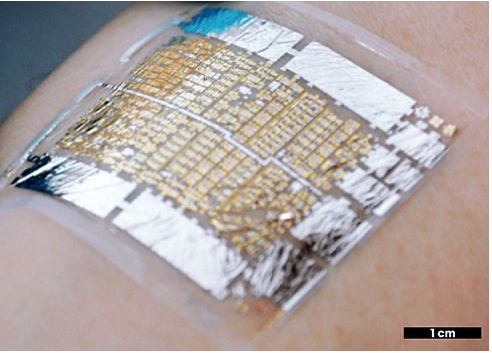
A team of researchers at Joanneum Research in Austria in cooperation with Osaka University, Japan, has developed an ultra-thin sensor that can measure various vital signs as well as absorb energy. Two years of research were spent on a barely detectable energy-absorbing sensor patch.
For many people, it is a necessary evil to measure their blood pressure and pulse three times a day. Unfortunately, the measuring devices used at home are usually perceived as unwieldy and uncomfortable, both in terms of size, weight and handling. This often leads to an unconscious stress situation in those affected and can lead to a falsification of blood pressure values, especially in the case of 24-hour measurements.
This situation motivated a team of researchers from Materials, the Institute of Surface Technology and Photonics at Joanneum Research, together with colleagues from Osaka University, to come up with a better solution. They developed an electronic sensor patch to measure health parameters so wafer-thin it can hardly be detected. Barbara Stadlober, Materials research group leader, says, “Our electronic sensor patches could be used in the future as part of screening for lifestyle-related illnesses such as cardiovascular disease, stress factors and sleep apnea.”
Wafer-thin film
This is done using a sensor material with the unpronounceable name poly(vinylidene difluoride – trifluoroethylene), which is applied to an ultra-thin film in conjunction with an electronic module weighing just a few grams.
Lead authors Andreas Petritz and Esther Karner-Petritz spent two years in Osaka conducting research at the Sekitani Lab and explain exactly how this works: “The P(VDF-TrFE) sensor material was deposited between two ultra-thin electrode surfaces on a carrier film made of parylene that is only 1 millionth of a meter thick. Due to its permanent electrical polarization, it is already highly sensitive to mechanical movements. It is therefore strongly piezoelectric. The key finding was that by avoiding a thick carrier substrate, the sensitivity could be increased many times over, allowing us to measure even the smallest changes in pressure, such as variations in the human pulse rate.”
The thickness effect could also be nicely demonstrated in simulations by co-author Philipp Schäffner. In addition to pulse rate, the sensor patch can also gather information on the elasticity of human blood vessels and measure blood pressure via pulse wave velocity. Particularly important: the measurement data can be transmitted wirelessly with the electronic module to a smartphone, for example.
Overall, the patch is no more than 0.0025 mm thick. As a result, it nestles completely comfortably against the skin. It is ultra-flexible – making it the world’s first ultra-flexible piezoelectric sensor.
Energy autonomous
What is particularly fascinating is that the sensor patch can also be used to generate electrical energy from biomechanical movements. But to efficiently extract energy from opposing joint movements, such as flexion-extension of the knee joint, the extracted currents must first be aligned. To do this, the researchers also developed circuits made of ultra-thin organic rectifier diodes and placed them on the thin carrier film, another new technique. Finally, the foil was given an ultra-thin capacitor structure for the intermediate storage of energy.
Barbara Stadlober explains: “Depending on the user’s activity, around 200 mJ of energy could be obtained per day. This would be sufficient for measuring blood pressure three times a day, provided that a lightweight, very low-consumption electronic module for wireless data transmission could be found. Unfortunately, these are still quite rare at present. But then nothing stands in the way of our dream of a wireless, completely energy-autonomous health patch that is extremely comfortable to wear.”
This research was published in the journal Nature Communications.
Also of interest: Nanosensor for detecting cancer in blood

